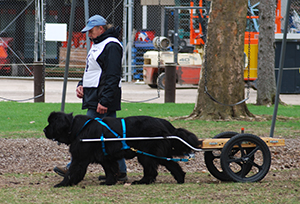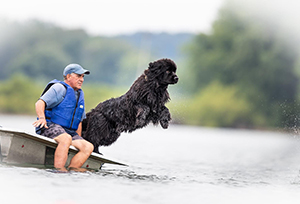Timeline: During The Test
Important Times:
• All entrants will check in with the Test Secretary during the advertised check in time. If a handler is not present during check-in time, an entrant from the alternate list will be assigned the absent handler’s position. For Draft Tests: handlers and dogs (except bitches in season) are allowed a thirty (30) minute period to familiarize themselves with the test areas at the start of each division. At least three (3) stewards must be available to walk entrants on the Distance Freight Haul course, and to monitor the test areas. Handlers may walk the course with their dogs on lead, but not hitched to an apparatus. Handlers will not be permitted to walk the Maneuvering or Distance Freight Haul courses after this time period.
• Thirty (30) minutes before the start of judging, handlers and stewards must meet with the judges for instructions. Judges will answer questions at this time.
• Water Tests: Exhibitors are allowed 15 minutes of pre-swim prior to their division judging
• Average Judging Times for Water Tests: 5 junior dogs per hour, 3 senior dogs per hour, 2 WRDX dogs per hour
• Average Judging Times for Draft Tests: 2 BDD dogs per hour not counting Freight Haul, 2 DD dogs per hour not counting Freight Haul, 2 DDX dogs per hour.
Set Up Your Site:
Rope, tape, fencing, or appropriate material to mark off the test area. The testing area should be large enough, such that each of the exercises in the test can be accommodated. The marking should clearly delineate spectator areas from the test area. Only members of the Test Committee, judges, and stewards have unlimited access to the testing areas. Only the current handler and dog being tested are permitted in the testing areas. **Draft Tests Only: At the judges’ discretion, unentered spectators may be permitted to follow the last entrant on the freight haul course but are not permitted in other testing areas.
Water Tests:For WD and WRD, two (2) sets of three (3) floating markers, placed at specified distances from shore on each side of the water testing area. They should be as unobtrusive as possible, visible to the entrants, but not attractive to the dogs. The markers must be a minimum of 75' apart, but test committees should use their judgement to provide the least distraction to dogs being tested, while providing clear visible markers for entrants and stewards. Three (3) markers set specified distance apart on shore as defined in the Regulations. It is strongly recommended that the 3 markers have other markers placed behind them in order to give a stronger line for the stewards to line up with.For WRDX 2 additional floating markers must be added and they must all be 100 feet apart.
The Draft Test Committee sets up and clearly marks a maneuvering course that includes as many natural features as possible. The judges will verify that the course meets the test criteria. If necessary, the judges may modify the course so that it adequately tests the handler and dog’s maneuvering abilities. The course must cover at least 150 yards and include the following:
• Circular patterns.
• Broad curves.
• Ninety-degree turns; at least one to the left and one to the right.
• At least two narrow areas six or more feet long; preferably one low to the ground (e.g., logs) and one solid narrow area a minimum of three feet high (e.g., stacked bales of hay).
• Removable obstacle.
Secretary's Table
The test secretary should have a table set-up for entrants to sign in and judges to collect their paperwork. 2-3 chairs for judges to sit while completing forms are appreciated. The table should be stocked with pens, clipboards, stapler, test catalogs, extra entry forms and all required grievance forms. It is helpful to have a large scoreboard to post results from each entrant. To avoid losing paperwork to inclement weather an E-Z Up or other shade cover is a good idea if the table is not located under cover. The secretary's table is used for: entrant sign-in and pick-up welcome packets; record test results during the event; keep all judging forms in order and assist the judges with wrap-up paperwork. If the test secretary is exhibiting at the test, a replacement should be assigned to cover the secretary's table during that time.
Collect Evaluations
Event Evaluations are now available for online completion (paper copies still available in the Form Library). Share these links with your entrants.
• Draft Test Exhibitor Evaluation: https://www.surveymonkey.com/r/QHVR6S7
• Draft Test Judges Evaluation: https://cloudstore.ncanewfs.org/index.php/apps/forms/s/Bz7ztdnJTYgLrrdjLioZSf9d
• Water Test Exhibitor Evaluation: https://cloudstore.ncanewfs.org/index.php/apps/forms/s/JLSTgqk6XB4nwjosHjQTqQpc
• Water Test Judges Evaluation: https://cloudstore.ncanewfs.org/index.php/apps/forms/s/CGaHPJW5T6WkCPbPPKY74Sop
Run Your Test
NCA Aggression Policy
Any dog, that in the opinion of the Event Committee, attacks a person or a dog at an NCA working event, resulting in an injury, and is believed by that Event Committee to present a hazard to persons or other dogs, shall be disqualified. When the dog is disqualified by the judges pursuant to this section, the judges must file a grievance with the NCA Working Dog Committee. The disqualified dog may not again compete at any NCA working event, nor be on the grounds of an NCA event unless and until, following application for reinstatement by the owner to the NCA Board, the owner receives official notification in writing from the NCA Board that the dog's eligibility has been reinstated.
Provisions For Disabled Handlers
Draft Tests:
The following provisions were approved to make it possible for more Newf owners to participate in draft tests who may have been unable to do so in the past. As a courtesy, entrants who wish to avail themselves of these accommodations should notify the test committee and the judges in advance.
1. Disabled handlers should be allowed to utilize whatever devices are needed to aid their mobility, such as a cane, crutch, or wheelchair, but these devices must not be used to control the dog in any way.
2. Certified assistance dogs should be allowed to wear a medpack and/or pull handle if such equipment is worn during the normal course of duty as an assistance dog, as long as they do not interfere with the performance of the harness and draft equipment.
3. The draft equipment and harness may be modified to accommodate the handler’s disabilities and to permit him/her to harness and hitch the dog without assistance, as long as the modified equipment is safe and comfortable for the dog.
4. A disabled person may bring an attendant, knowledgeable in assisting the handler with his/her disabilities, to accompany the handler on the maneuvering and freight haul exercises. The role of the attendant is to assist the handler with mobility, if needed, due to the rough or uneven terrain of the course, and to look out for the person’s safety. The attendant should walk slightly behind the handler on the right side, to be in a position to provide assistance, yet out of the line of sight of the dog, and on the opposite side from the handler’s official test steward. The attendant may not touch, speak to, or interact with the dog in any way.
5. The AKC Guidelines for accommodating disabled handlers in Obedience will apply for the Basic Control Exercise.

